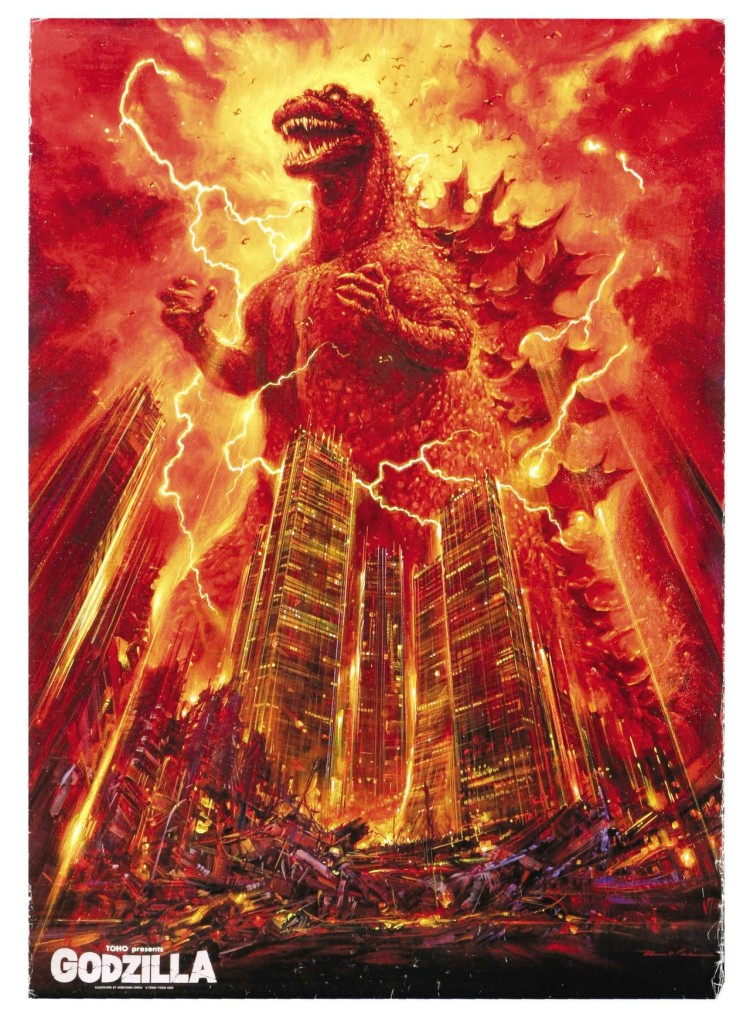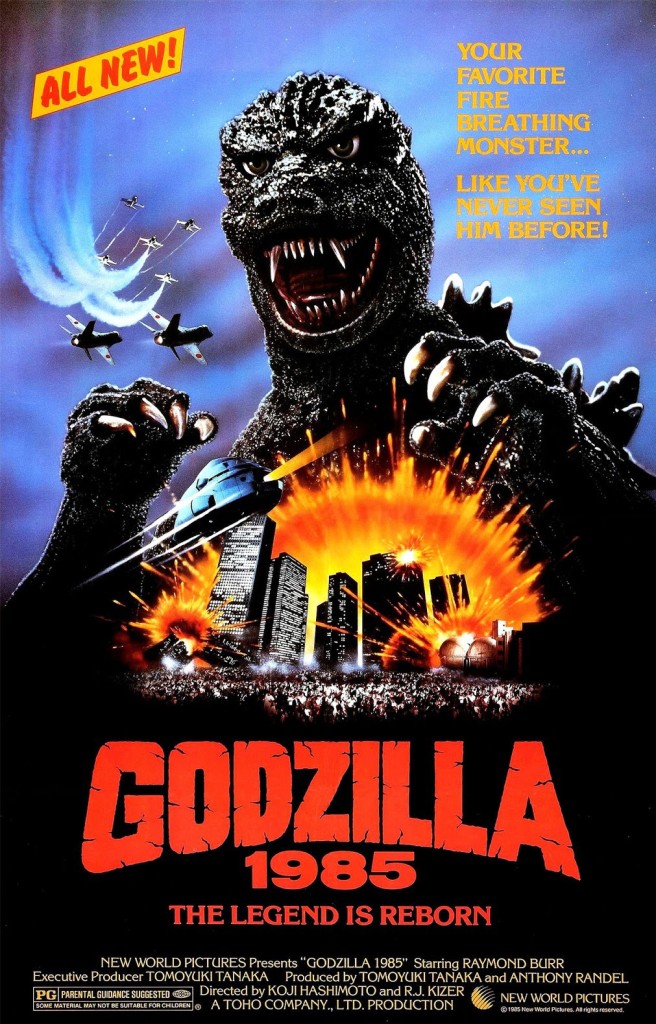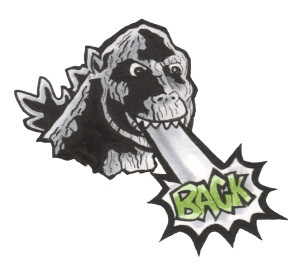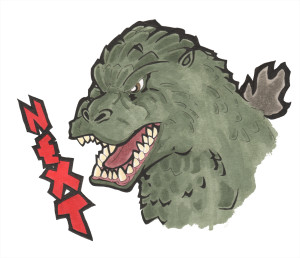Return of Godzilla/Godzilla 1985 ~ 1984, Koji Hashimoto (Japan)/1985 R.J. Kizer (USA)

After a nine year break, Toho returns with a full on reboot of the Godzilla franchise that ignores a whopping twenty years worth of movie continuity, which isn’t a problem, because ignoring continuity is something Toho has always been excellent at anyway. This time around, we acknowledge only 1954’s Gojira as cannon, and begin with a brand new storyline which would later become known as the Heisei series. Because we’ve taken thirty or so movies and completely thrown them in the trash, we’ve erased Godzilla’s transformation into the grumbling, heroic Guardian monster he had grown into in his later films, and so the monster we see now is again painted more as a horrible, planet-wide menace that must be destroyed. This movie is super, super grim, and when you look at our last dozen outings with Big G, this couldn’t be a more different experience. At the same time, however, because this is still an accurate continuation of the original Godzilla concept, and because previous films have also proven that there is enough room within the Godzilla format for more than one idea, this dramatic shift in tone does not make Return of Godzilla feel like an illegitimate sequel. It still works just fine.
THE PLOT~ Thirty years after the original Godzilla monster attacked Japan and was subsequently destroyed, a second, identical monster surfaces in the Pacific Ocean and starts smashing boasts and killing people. Japan becomes aware of the situation almost immediately, but chooses to suppress this information for fear of causing unnecessary panic amongst the already tense Global Political Stage. Soon, however, they have no choice, as Godzilla strikes down a Soviet Nuclear Submarine and causes a heated international incident. Assuming that only the United States could have been behind the attack on their submarine, the Soviet Union threatens to escalate this situation to full scale nuclear warfare, and Japan is forced to announce the existence of Godzilla as a means of diffusing the situation. This only brings Japan’s government new pressures from both the Americans and the Russians in regards to how to handle this big green bastard and his boat smashin’ ways, and everybody gets super stressed out. The rest of the picture balances Japan’s war with Godzilla and their deep seeded abhorrence of Nuclear weapons with cold war tensions and international bickering, making this film an effective means of addressing where the Nuclear Discussion had moved to in the mid 1980’s. That feels pretty appropriate, given Godzilla’s atomic bomb history, but we also see a lot of Godzilla thrashing about and being shot at, so don’t worry about spending too much time watching old dudes in suits yell at each other.
In terms of our human characters, we have several, but holy shit, who cares? They’re all fine, I guess, but we don’t really care about them all that much. Be honest, we almost never do.
I think Toho kind of assumed that since the later Godzilla films had become so popular with a younger audience, that these kids had now grown up, and were ready for a Godzilla film more their speed, and that’s fair enough. What Return/1985 does best is that it stays true to the concept behind the original Gojira film, while at the same time making it current to the early 80’s, and that’s cool. It’s all about nuclear war, how devastating it can be, what it means for humanity to now possesses this power, and above all, how we can work to avoid using nuclear weapons ever again. As I said before, I think this is a logical place for this franchise to go, and I think they’ve done it pretty well. The tense atmosphere of the Cold War is certainly captured effectively, and the seriousness with which nuclear warfare, and even Godzilla himself, are handled gives the movie a much less schlocky feel. I think it’s entertaining enough, even without another monster for Godzilla to wail on, but if I’m wrong on that, audiences won’t have long to wait for a return to the Monsters V. Monster format, cuz Godzilla Vs. Biolante is just around the corner.
GODZILLA 1985

Like Gojira in 1954, Return of Godzilla was also re-edited for American audiences to include footage of white people, because no one knows what would happen if Americans had to watch a movie without white people in it, and for sure, nobody wants to find out. In the case of the original film, the American version became known as Godzilla: King of the Monsters, and in the case of Return of Godzilla, the American version is called Godzilla 1985. In both cases, the special Caucasian-ified American version features celebrated actor Raymond Burr as a journalist named Steve Martin, but to what degree this new footage is imposed on the original, and what effect that has on the film as a whole, could not be more different in Godzilla 1985 than it was in King of the Monsters. We do lose some of the nuclear paranoia, but we still fair MUCH better this time around.
While still a classic film, Godzilla: King of the Monsters was clearly inferior to it’s Japanese sibling, which already had excellent characters and compelling drama BEFORE we crammed in a bunch of white folks. In that case, the addition of Raymond Burr’s character only distanced the audience from the real story, and that softened the film’s impact a great deal. With Godzilla 1985, though, I don’t think this is the case at all. This time around we still spend ample time in Japan with our original characters, and their stories and relationships are not so badly cheated in the same way. Additionally, Raymond Burr adds a special connection to the first film, even if he wasn’t in Gojira we know he was in King of the Monsters, and his character is very well written and acted this time around. The best thing this Westernized version does, however, is that it expands Godzilla’s presence to a global level much better than the Japanese one does. In this version, the Americans learn about Godzilla much sooner, and we come to learn that they are every bit as stressed out about it as the Japanese are, which really elevates the tension. I may be committing some weird form of Godzilla treason here, but I actually like the American version better for exactly these reasons. And Burr is kicking out the Jams, too.
Regardless of which version you see, however, this is a nice entry in the series, and a great way to jumpstart a new slew of giant, monster clobbering adventures. Many of the effects have not held up well for their age, but they shouldn’t slow you down too much, it’s still plenty enjoyable for the seasoned Toho fan.
B-


